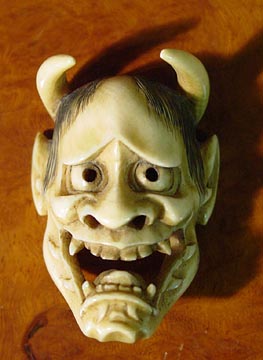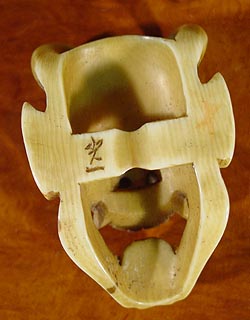|
The William Oates Jeffery Collection - Netsuke, Ojime, and other Ivory Objects |
|
|
|
Hannya Noh Mask Netsuke Hannya - Spirit / Demon 19th century AD SOLD
Beautifully done 19th century ivory netsuke portraying a Hannya Noh Mask.
Hannya is the best known and most fearsome character in Noh drama. Hannya represents a once beautiful woman who has turned into a demon by her jealousy. The mask expresses the intensity of her resentment and anger with its long horns, gaping mouth, fangs, prominent eyes under an overhanging brow, disheveled hair, pointed ears, and triangular chin. |
|
|
The Noh play "Dojoji" tells the story of Kiyohime and her love for the priest Anchin. Kiyohime relentlessly pursued Anchin into the Buddhist temple of Dojo-ji, where he hid himself under the temple bell to escape her. When the beautiful young woman was rejected, she turned into a ferocious demon headed serpent, coiling around the bell, and both were burned into ashes by her rage.
dimensions: 2 1/8" high x 1 1/2" wide x 7/8" deep Two ( himotochi ) holes in back.
Signed. Artist Unknown
|
|
Noh was the theater of royalty in Japan in the 1300s and 1400s. Noh plots usually have tragedy, loyalty, and honor as their themes. Sometimes Noh includes a slow, controlled form of dance. Noh actors wear elaborate costumes, and the main characters wear masks in order to take on the role of the many different characters that they play. Noh masks represent women, old men, and supernatural beings with different moods and personalities. Actors are all male, even those with female roles. The band for Noh theater includes a bamboo flute, three drums, and a male vocal ensemble that tells the story in song. Occasionally, drum calls are played during the performance.
Noh masks, also known as omote, are important props in the Noh masked drama. In documents from the Momoyama period, about 60 types of masks are listed, and these account for most of the masks in use today. Most but not all shite roles require the use of a mask, excepting the roles of kokata (child actors) and actual living men, which are performed without a mask. Within established limits, there are specific masks used for each type of character. The actor performing the shite role chooses the most appropriate mask based upon his idea of the subject matter and his plan for the performance. |
|
|
for inquiries email info@galwest.com |
|
All pages on this web site are copyright 1998 to 2016 by Williams Gallery West

